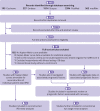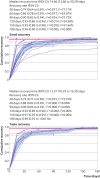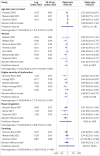Prognosis and persistence of smell and taste dysfunction in patients with covid-19: meta-analysis with parametric cure modelling of recovery curves
- PMID: 35896188
- PMCID: PMC9326326
- DOI: 10.1136/bmj-2021-069503
Prognosis and persistence of smell and taste dysfunction in patients with covid-19: meta-analysis with parametric cure modelling of recovery curves
Erratum in
-
Prognosis and persistence of smell and taste dysfunction in patients with covid-19: meta-analysis with parametric cure modelling of recovery curves.BMJ. 2022 Aug 9;378:o1939. doi: 10.1136/bmj.o1939. BMJ. 2022. PMID: 35944915 Free PMC article. No abstract available.
Abstract
Objective: To clarify in patients with covid-19 the recovery rate of smell and taste, proportion with persistent dysfunction of smell and taste, and prognostic factors associated with recovery of smell and taste.
Design: Systematic review and meta-analysis.
Data sources: PubMed, Embase, Scopus, Cochrane Library, and medRxiv from inception to 3 October 2021.
Review methods: Two blinded reviewers selected observational studies of adults (≥18 years) with covid-19 related dysfunction of smell or taste. Descriptive prognosis studies with time-to-event curves and prognostic association studies of any prognostic factor were included.
Data extraction and synthesis: Two reviewers extracted data, evaluated study bias using QUIPS, and appraised evidence quality using GRADE, following PRISMA and MOOSE reporting guidelines. Using iterative numerical algorithms, time-to-event individual patient data (IPD) were reconstructed and pooled to retrieve distribution-free summary survival curves, with recovery rates reported at 30 day intervals for participants who remained alive. To estimate the proportion with persistent smell and taste dysfunction, cure fractions from Weibull non-mixture cure models of plateaued survival curves were logit transformed and pooled in a two stage meta-analysis. Conventional aggregate data meta-analysis was performed to explore unadjusted associations of prognostic factors with recovery.
Main outcome measures: The primary outcomes were the proportions of patients remaining with smell or taste dysfunction. Secondary outcomes were the odds ratios of prognostic variables associated with recovery of smell and taste.
Results: 18 studies (3699 patients) from 4180 records were included in reconstructed IPD meta-analyses. Risk of bias was low to moderate; conclusions remained unaltered after exclusion of four high risk studies. Evidence quality was moderate to high. Based on parametric cure modelling, persistent self-reported smell and taste dysfunction could develop in an estimated 5.6% (95% confidence interval 2.7% to 11.0%, I2=70%, τ2=0.756, 95% prediction interval 0.7% to 33.5%) and 4.4% (1.2% to 14.6%, I2=67%, τ2=0.684, 95% prediction interval 0.0% to 49.0%) of patients, respectively. Sensitivity analyses suggest these could be underestimates. At 30, 60, 90, and 180 days, respectively, 74.1% (95% confidence interval 64.0% to 81.3%), 85.8% (77.6% to 90.9%), 90.0% (83.3% to 94.0%), and 95.7% (89.5% to 98.3%) of patients recovered their sense of smell (I2=0.0-77.2%, τ2=0.006-0.050) and 78.8% (70.5% to 84.7%), 87.7% (82.0% to 91.6%), 90.3% (83.5% to 94.3%), and 98.0% (92.2% to 95.5%) recovered their sense of taste (range of I2=0.0-72.1%, τ2=0.000-0.015). Women were less likely to recover their sense of smell (odds ratio 0.52, 95% confidence interval 0.37 to 0.72, seven studies, I2=20%, τ2=0.0224) and taste (0.31, 0.13 to 0.72, seven studies, I2=78%, τ2=0.5121) than men, and patients with greater initial severity of dysfunction (0.48, 0.31 to 0.73, five studies, I2=10%, τ2<0.001) or nasal congestion (0.42, 0.18 to 0.97, three studies, I2=0%, τ2<0.001) were less likely to recover their sense of smell.
Conclusions: A substantial proportion of patients with covid-19 might develop long lasting change in their sense of smell or taste. This could contribute to the growing burden of long covid.
Systematic review registration: PROSPERO CRD42021283922.
© Author(s) (or their employer(s)) 2019. Re-use permitted under CC BY-NC. No commercial re-use. See rights and permissions. Published by BMJ.
Conflict of interest statement
Competing interests: All authors have completed the ICMJE uniform disclosure form at www.icmje.org/coi_disclosure.pdf and declare: no support from any organisation for the submitted work; no financial relationships with any organisations that might have an interest in the submitted work in the previous three years; no other relationships or activities that could appear to have influenced the submitted work.
Figures





Comment in
-
Smell and taste dysfunction after covid-19.BMJ. 2022 Jul 27;378:o1653. doi: 10.1136/bmj.o1653. BMJ. 2022. PMID: 35947733 No abstract available.
References
-
- Lechien JR, Chiesa-Estomba CM, De Siati DR, et al. . Olfactory and gustatory dysfunctions as a clinical presentation of mild-to-moderate forms of the coronavirus disease (COVID-19): a multicenter European study. Eur Arch Otorhinolaryngol 2020;277:2251-61. 10.1007/s00405-020-05965-1 - DOI - PMC - PubMed
Publication types
MeSH terms
Grants and funding
LinkOut - more resources
Full Text Sources
Medical
